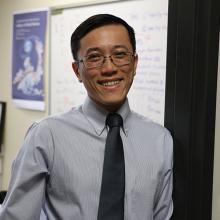Developing a Tool for Fuel Efficiency
While engineers understand the fundamentals of the way liquid fuel behaves inside an engine, a vast number of variables make it difficult to predict its efficiency. The interplay of small fuel droplets and air impacts the performance of a variety of combustion engines — and it’s a factor that a Baylor ECS professor has received a substantial award to study.
Stanley Ling, PhD, Assistant Professor of Mechanical Engineering at Baylor, has won a National Science Foundation (NSF) CAREER Grant — the most prestigious honor and significant funding mechanism the organization awards young researchers — to pioneer the understanding of these complicated conditions through rigorous modeling and high-powered computing. The end result of his research will be fuel injection systems that are more efficient and create less pollution.
Build a Better Program
Ralph Waldo Emerson, a 19th century essayist, is famous for the phrase, “Build a better mousetrap, and the world will beat a path to your door.” Dr. Ling’s approach is to empower others to build better systems.
Rather than building a better fuel injection system or engine, Ling, seeks to de-mystify variables and equations to provide insight into fuel and air’s interplay. To create such a program would require a more comprehensive grasp of the myriad variables that take place once the fuel is injected. These variables, impacting the size, distribution, binding and dynamic characteristics, are vast and little understood, but impact the way fuel burns, the efficiency in which it powers the engine and the pollution created.
“The good news is that the energy channels for the motion of the fuel, the air, and how they mix together are analyzed by a set of equations,” Ling said. “However, the equations are very difficult to solve. It requires a super computer and numeric coding. We aim to create never-developed methods to test and model spray formation, and create an efficient software to give to engineers and researchers — a powerful tool to tackle these problems.”
“With this advanced understanding of droplets, we will use these methods to develop a software that is both powerful and efficient — complex enough to provide the detail they need, but without requiring the computing power currently necessary.”
Engineers need precision for what seems imprecise. To this point, no one has advanced comprehensive understanding on the matter. Part of the reason why represents another side of the challenge: to do the number of simulations necessary to understand the variables requires tides of data, countless models, and lots of money — factors beyond the scope of most designers to harness.
In Ling’s lab, the Computational Thermo-Fluid Laboratory, he will utilize his NSF grant, first, to begin that modeling, then to create an application that harnesses the insights that modeling delivers. The goal is to package it in a program that requires less computer power and is more affordable than anything currently available — a tool for engineers around the world to use to build greater efficiency and less pollution, one design at a time.
Baylor Supercomputing
Towards that end, Ling utilizes the power of high-performance computing at Baylor. His data is a regular guest within Baylor’s supercomputer, Kodiak. There, rigorous calculations and simulations utilize thousands of CPUs needed to develop models accounting for spray variables, and a process used in video games is an important tool.
“A very important, innovative idea in this project is that we use something called skeletonization to look at a spray,” Ling said. “In video games, people have used what they call a skeleton, in presentation, for complicated 3D objects. For example, with a human body, we try to get only the skeleton of a very abstract presentation for a simplified model. A spray contains very complicated liquid structures, so for a spray, we use the same idea — to get a skeleton of it and then model the physical process space on that skeleton. That is how we strive for the solid simulation data, and that's why we need a super computer.”
Through skeletonization and repeated simulations, Ling seeks to develop the 3D models necessary to understand spray behavior comprehensively. As he does so, he’s utilizing computing power he hopes to save for future engineers, cutting the amount of energy they need to address these challenges.
“With this advanced understanding of droplets, we will use these methods to develop a software that is both powerful and efficient — complex enough to provide the detail they need, but without requiring the computing power currently necessary.”
Benchmarks for Mechanical Engineering and Baylor’s Research Vision
Dr. Ling’s CAREER award comes at a highly-decorated time in Baylor research. Four professors earned NSF CAREER awards this spring — the most in a year in school history. It also represents a first for Baylor Mechanical Engineering. These highly-competitive awards are presented to a select group of scholars who, as the NSF explains, “have the potential to serve as academic role models in research and education and to lead advances in the mission of their department or organization.”
“I’m very thankful for the support of the School of Engineering and Computer Science,” Ling said. “They provided me with all the research resources and facilities I need, as well as student support so that I could get the preliminary data to launch the CAREER award. At the same time, this is also very important to our school as it is the first for Mechanical Engineering. Across Baylor, there’s an environment in which everyone works together and pursues each other’s shared success. That, along with our Christian values and pursuit of becoming a Christian research university make Baylor so unique.”
